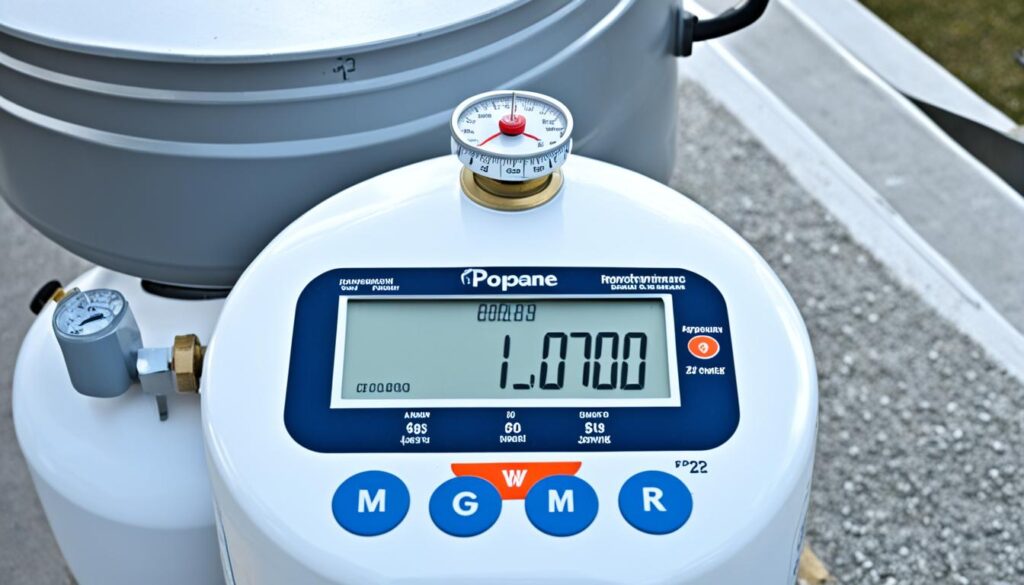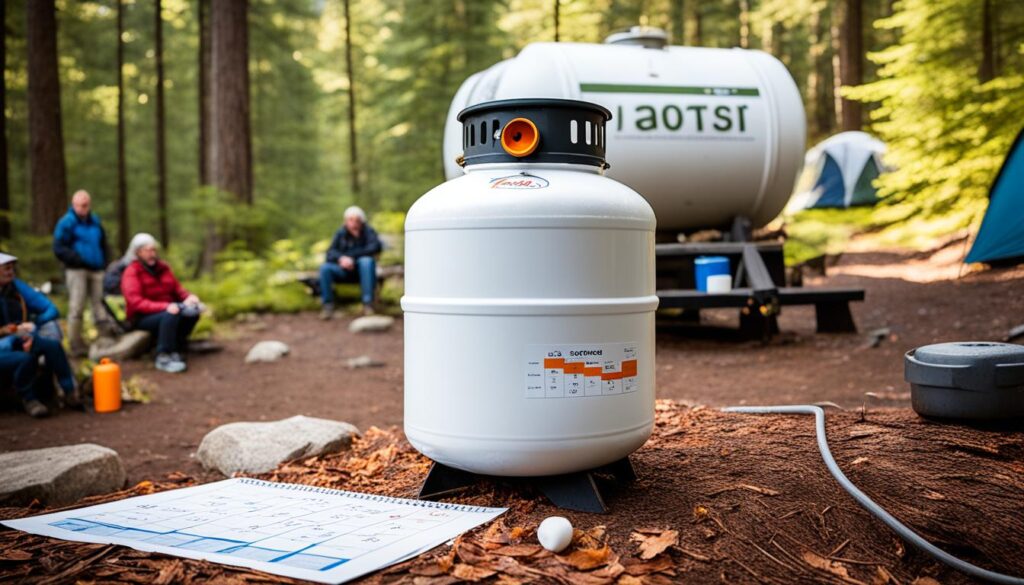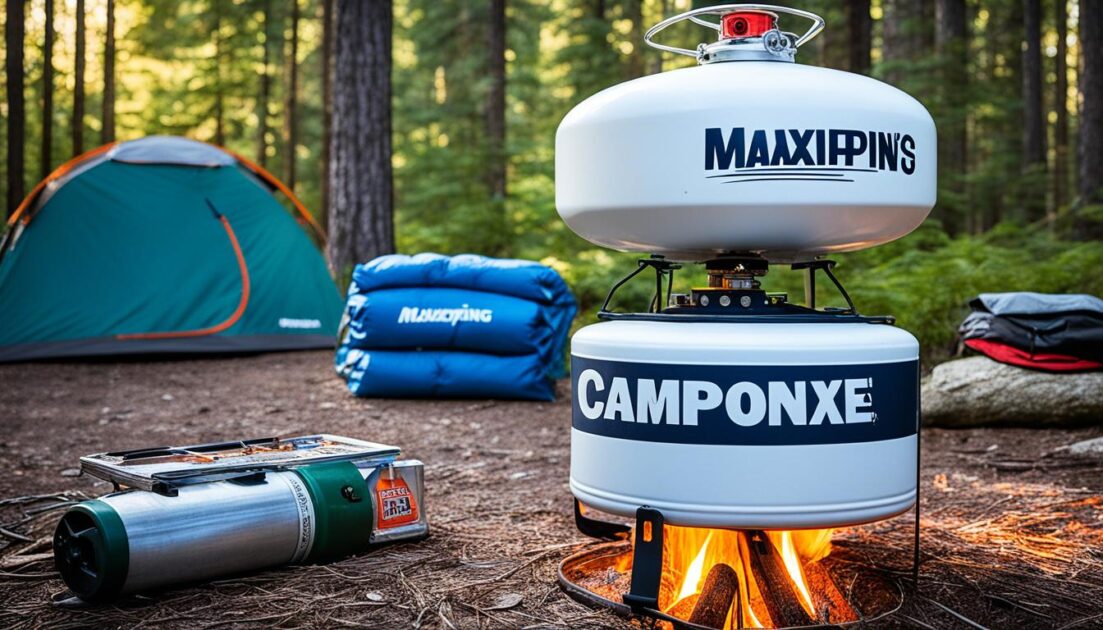When it comes to camping, a reliable propane tank is a must-have for heating, cooking, and powering your camping appliances. But have you ever wondered how long your camping propane tank will last? Understanding the factors that affect the lifespan of your tank and how to maximize its usage can make your camping experience more enjoyable and hassle-free.
Key Takeaways:
- The size of the propane tank, temperature and climate, frequency of usage, and type of appliance or equipment all impact its lifespan.
- Calculating your propane tank usage based on BTU ratings and average consumption can help you estimate how long your tank will last during your camping trip.
- On average, camping propane tanks can last for a few years but require proper maintenance.
- Visual and performance indicators, such as frost on the tank and weak flame, can signal that your propane tank is running low.
- Following safety precautions is essential when handling, storing, and using propane tanks.
Factors Affecting Propane Tank Usage
The lifespan of a camping propane tank can vary depending on several factors. Understanding these factors is crucial for maximizing the usage and lifespan of your propane tank.
Size of the Propane Tank
The size of the propane tank plays a significant role in its lifespan. Larger tanks can hold more propane, allowing for a longer usage duration compared to smaller tanks. If your camping trips are longer or you frequently use propane for various appliances, opting for a larger tank may be beneficial.
Temperature and Climate
The temperature and climate of your camping location can impact the efficiency of propane usage. In colder conditions, such as during winter camping, propane may vaporize more slowly, reducing the overall lifespan of the tank. Conversely, in hotter climates, propane can vaporize more rapidly, leading to faster consumption. It is important to consider these factors when estimating the duration of your propane supply.
Frequency of Usage
The frequency at which you use your propane tank also affects its lifespan. Regular usage can deplete the propane supply more quickly, shortening the overall duration. If you plan to use propane for extended periods or frequently, it may be necessary to carry additional tanks or refill your tank more often.
Type of Appliance or Equipment
The type of appliance or equipment being used with the propane tank can impact its lifespan. Some appliances, such as high BTU burners or grills, consume propane at a faster rate than others. It is important to consider the propane consumption of your appliances when estimating the usage duration of your tank.
By considering these factors and taking appropriate measures, you can prolong the lifespan of your camping propane tank and ensure a steady supply of fuel for your camping needs.

Calculating Propane Tank Usage
Estimating propane consumption and accurately calculating propane tank usage are essential for planning your camping trip and ensuring a sufficient fuel supply. By considering factors such as the BTU rating of your appliances, the size of your tank, and the average propane consumption per hour, you can determine how long your tank will last. Here is a step-by-step guide to help you calculate propane tank usage:
- Identify the BTU rating: Start by identifying the BTU (British Thermal Unit) rating of each of your propane-powered appliances. This information is usually provided in the product’s specifications or manual.
- Calculate the total BTU consumption: Add up the BTU ratings of all the appliances you plan to use during your camping trip. This will give you the total BTU consumption per hour.
- Determine the average propane consumption: To estimate the average propane consumption per hour, divide the total BTU consumption by the BTU content of a gallon of propane. On average, one gallon of propane contains approximately 91,500 BTUs.
- Estimate the propane usage: Now that you have the average propane consumption per hour, you can estimate how much propane will be consumed during your camping trip. Multiply the average consumption per hour by the number of hours you plan to use the appliances each day.
- Consider the size of your propane tank: To determine how long your propane tank will last, divide the total estimated propane usage by the capacity of your tank. Take note of the tank’s capacity, which is usually indicated in pounds or gallons.
By following this calculation process, you can get a rough estimate of your propane tank’s usage and determine whether you need to refill or bring an additional tank for your camping trip. It’s always better to be prepared and avoid running out of propane during your outdoor adventures.
For reference, below is a visual representation of the calculation process:

Keep in mind that these calculations provide approximate estimations, as actual propane usage can vary depending on factors such as the efficiency of your appliances, outdoor temperature, and personal usage habits. Monitoring your tank’s fuel level and having a backup plan for propane refills is recommended to ensure a hassle-free camping experience.
Average Propane Tank Lifespan
In order to make the most of your camping experience, it’s important to understand the average lifespan of a camping propane tank. The lifespan of a propane tank can vary depending on several factors, including its size, usage, and maintenance. Smaller tanks that are commonly used for camping typically last for a few years, while larger tanks that are utilized for residential or commercial purposes can last for decades if properly maintained.
Proper maintenance plays a key role in extending the lifespan of your camping propane tank. Regular inspections, cleaning, and ensuring proper storage can help prevent damage and ensure optimal performance for years to come. Additionally, using the tank within its intended usage limits and following safety protocols can also contribute to its longevity.
To provide a clearer understanding, here’s a table highlighting the average propane tank lifespan based on its size:
| Propane Tank Size | Average Lifespan |
|---|---|
| Small (up to 1 lb) | 3-5 years |
| Medium (2-20 lbs) | 5-10 years |
| Large (20-100 lbs) | 10-20 years |
It’s important to note that these are average estimates and can vary based on individual usage patterns and maintenance practices. By following proper care and maintenance guidelines, you can ensure that your camping propane tank serves you well throughout its lifespan.

Signs That Your Propane Tank Is Running Low
When you’re out camping, it’s crucial to keep track of your propane tank’s fuel level to avoid any unexpected interruptions in your outdoor cooking or heating plans. Fortunately, there are several indicators that can help you determine when your propane tank might be running low. By paying attention to these signs, you can ensure that you never run out of propane in the middle of your camping trip.
Visual Indicators
Visual indicators are one of the easiest ways to check the fuel level in your propane tank. When your tank is running low, you may notice frost or condensation forming on the outside of the tank, especially in humid or colder climates. Additionally, most propane tanks come equipped with a tank gauge that displays the current fuel level. Take a moment to check the gauge regularly to ensure that you have enough propane for your camping needs.
Performance Indicators
In addition to visual cues, you can also rely on performance indicators to determine if your propane tank is running low. One common performance indicator is a weak flame or poor heating performance from gas-powered appliances such as stoves, grills, and heaters. If you notice that the flame produced by your appliance is significantly smaller or weaker than usual, it might be an indication of low propane levels. Similarly, if your appliances take longer to ignite or struggle to maintain a consistent flame, it could be a sign that your tank is running low on fuel.
By paying attention to these low propane tank indicators, you can take proactive steps to refill or replace your tank before it becomes empty. Running out of propane in the middle of your camping trip can disrupt your plans and leave you without essential resources. Remember to regularly check the visual and performance indicators to ensure that you have enough fuel to enjoy your outdoor adventures to the fullest.
| Visual Indicators | Performance Indicators |
|---|---|
| – Frost on the outside of the tank | – Weak flame |
| – Condensation on the tank | – Poor heating performance |
| – Low fuel level in the tank gauge | – Slow ignition of appliances |
Safety Precautions When Using a Propane Tank
When it comes to propane tank safety, proper handling and storage are essential. Here are some guidelines to follow to ensure the safe usage of your propane tank:
- Always store propane tanks in a well-ventilated, outdoor area away from flammable materials and ignition sources.
- Ensure that the tank is in an upright position and secure to prevent any tipping or damage.
- Regularly inspect the tank for any signs of damage, such as dents or rust, and promptly replace any damaged tanks.
- When transporting a propane tank, secure it in an upright position and never leave it inside a closed vehicle.
It is also crucial to know the emergency procedures in case of a gas leak or other safety concern:
- If you smell gas, leave the area immediately and evacuate any nearby buildings.
- Do not use any ignition sources, including light switches or matches, as they can ignite the gas.
- From a safe distance, call your local fire department or propane supplier to report the leak.
- Do not attempt to repair a leaking propane tank yourself. Leave it to trained professionals.
Using Propane Tanks Responsibly
Proper handling and storage of propane tanks are crucial to ensure the safety of yourself and those around you. Always follow the recommended guidelines and procedures to prevent accidents and potential hazards.
Remember, using propane tanks for their intended purposes is vital. Avoid using damaged or expired tanks, as they can pose significant risks. Regular inspection and maintenance will help ensure the safe and efficient operation of your propane tank.
How to Maximize Your Tank Usage
Proper tank maintenance is crucial for optimizing the lifespan of your camping propane tank and ensuring efficient usage. By following these tips, you can make the most of your propane tank and enhance your camping experience:
Keep the Tank and Components Clean
A clean propane tank and its components help maintain optimal performance and prevent any potential issues. Regularly inspect and clean the tank, regulator, and hoses to remove any dirt, debris, or rust. This will ensure a smooth flow of propane and prevent any blockages or disruptions during your camping trip.
Store the Tank in a Safe Location
Proper storage is essential to protect your propane tank from damage and ensure its longevity. When not in use, store the tank in a well-ventilated area away from direct sunlight, heat sources, and flammable materials. It is also advisable to keep the tank in an upright position to prevent any leaks or accidents.
Regularly Inspect by a Professional
Hiring a professional for regular inspections and maintenance can help identify any potential issues early on and ensure the safe and efficient operation of your propane tank. They will check for leaks, pressure levels, and overall tank condition to address any concerns promptly before they become major problems.
Use Energy-Efficient Appliances and Conservation Techniques
To minimize propane usage and make your tank last longer, choose energy-efficient camping appliances and equipment. Opt for devices with lower BTU ratings, as they require less propane to function. Additionally, practice conservation techniques like turning off appliances when not in use and using alternative fuel sources when possible. This will help maximize your tank’s usage and minimize the need for frequent refills.
By implementing these tips, you can effectively maximize the usage of your camping propane tank and ensure a reliable fuel source throughout your camping adventures.
Differences Between Propane and Natural Gas Usage
When it comes to fuel sources for heating and powering household appliances, two popular options are propane and natural gas. Understanding the differences between propane and natural gas usage is crucial for selecting the right option for your camping and outdoor activities.
Propane is a liquefied petroleum gas (LPG) that is stored in portable tanks, making it highly versatile and easy to transport. It is widely available and can be used in areas where natural gas pipelines aren’t accessible. On the other hand, natural gas is a fossil fuel that is delivered directly to homes via underground pipelines, ensuring a continuous supply.
Cost-wise, propane tends to have a higher price per unit compared to natural gas. However, the efficiency of propane appliances allows for a faster heating and cooking process, potentially offsetting the higher cost. Additionally, natural gas is often subject to fluctuating prices, depending on market conditions.
When it comes to environmental impact, both propane and natural gas are cleaner-burning fuels compared to other fossil fuels, such as coal or oil. However, natural gas tends to be slightly cleaner as it produces fewer greenhouse gas emissions. Propane, on the other hand, is non-toxic and doesn’t harm soil or water if there is a leak or spillage.
FAQ
How long does a camping propane tank typically last?
The lifespan of a camping propane tank can vary depending on factors such as size, usage, and maintenance. Smaller tanks used for camping typically last for a few years, while larger tanks used for residential or commercial purposes can last for decades if properly maintained.
What factors affect the lifespan of a camping propane tank?
The size of the propane tank, temperature and climate, frequency of usage, and type of appliance or equipment all play a role in determining how long a camping propane tank will last.
How do I calculate the usage and duration of my camping propane tank?
To estimate the amount of propane you need and how long your camping propane tank will last, you can calculate your propane usage based on the BTU rating of your appliances, the size of your tank, and the average propane consumption per hour.
What is the average lifespan of a camping propane tank?
The average lifespan of a camping propane tank can vary depending on factors such as size, usage, and maintenance. Smaller tanks used for camping typically last for a few years, while larger tanks used for residential or commercial purposes can last for decades if properly maintained.
How can I tell when my propane tank is running low?
There are several visual and performance indicators that can signal when your propane tank is running low. Visual indicators include frost on the outside of the tank and a low fuel level in the tank gauge. Performance indicators include a weak flame or slow ignition of gas-powered appliances.
What safety precautions should I take when using a propane tank?
It is crucial to follow safety guidelines when using a propane tank. This includes proper handling and storage of the tank, regular inspection and maintenance, and knowing emergency procedures in case of a gas leak or other safety concern.
How can I maximize the usage of my camping propane tank?
Proper tank maintenance is essential for maximizing its lifespan and ensuring efficient usage. This includes keeping the tank and its components clean, storing it in a safe location, having it inspected regularly by a professional, and using energy-efficient appliances and conservation techniques to minimize propane usage.
What are the differences between propane and natural gas usage?
Propane and natural gas are both commonly used as fuel sources for heating and powering household appliances. This section will discuss the differences between propane and natural gas usage, including their availability, cost, and environmental impact.
Source Links
- https://heatauthority.com/blogs/news/how-many-hours-does-a-propane-tank-last
- https://www.touristsecrets.com/travel-guide/adventure/propane-tanks-in-camping-how-long-can-you-expect-them-to-last/
- https://www.campgroundviews.com/rv-propane-tank-lifespan-how-long-does-it-last-for-heating-fridge-and-water/

